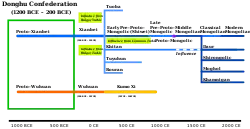| Para-Mongolic | |
|---|---|
| Serbi–Awar (Xianbei–Wuhuan) Serbi (Xianbei) | |
| (proposed) | |
| Geographic distribution | Mongolia, northern China, Lake Baikal region |
| Linguistic classification | ? Serbi–Mongolic
|
| Subdivisions | |
Para-Mongolic is a proposed group of languages that is considered to be an extinct sister branch of the Mongolic languages. Para-Mongolic contains certain historically attested extinct languages, among them Khitan and Tuyuhun.
Languages

The languages of the Xiongnu, Donghu and Wuhuan might be Para-Mongolic,[1] as might those of the Xianbei and the Tuoba (the founders of the Northern Wei) and Khitan. Because the surviving evidence for Xianbei and Tuoba is very sparse, one can only hypothesize that a genetic relationship could be possible. In the case of Khitan, there is rich evidence, but most of it is written in the two Khitan scripts (large and small) that have yet to be fully deciphered. However, from the available evidence it has been concluded that a genetic relationship to Mongolic is likely.[2][3]
Tuoba
Alexander Vovin (2007) identifies the extinct Tuoba language (Tabγač) as a Mongolic language.[4] However, Chen (2005)[5] argues that Tuoba was a Turkic language.
Shimunek classifies Tuoba as a "Serbi" (i.e., para-Mongolic) language, along with Tuyuhun and Khitan.[6]
Rouran
Alexander Vovin (2018) suggests that the Rouran language of the Rouran Khaganate was a Mongolic language, close but not identical to Middle Mongolian.[7]
Khitan
Juha Janhunen (2006) classified the Khitan language into the "Para-Mongolic" family, meaning that it is related to the Mongolic languages as a sister group, rather than as a direct descendant of Proto-Mongolic.[8] Alexander Vovin (2017)[9] has also identified several possible loanwords from Koreanic languages into the Khitan language.
Tuyuhun
Vovin (2015) identified the extinct Tuyuhun language as a Para-Mongolic language.[10]
Internal classification
Shimunek (2017) proposes a "Serbi–Awar" group of languages that is a sister branch of the Mongolic languages. Together, the Serbi–Awar and Mongolic languages make up the Serbi–Mongolic languages in Shimunek's classification.[6]
- Serbi–Mongolic
- Mongolic
- Serbi–Awar (= Juha Janhunen's "Para-Mongolic")
- Awar (Avar) (Wuhuan 烏桓 or Wuwan 烏丸)
- Old Serbi (Common Serbi)
See also
References
- ↑ Andrews 1999, p. 72.
- ↑ Janhunen 2003b, pp. 391–394.
- ↑ Janhunen 2003a, pp. 1–3.
- ↑ Vovin, Alexander (2007). "Once again on the Tabγač language". Mongolian Studies. XXIX: 191–206.
- ↑ Chen, Sanping (2005). "Turkic or Proto-Mongolian? A Note on the Tuoba Language". Central Asiatic Journal. 49 (2): 161–73.
- 1 2 Shimunek, Andrew (2017). Languages of Ancient Southern Mongolia and North China: a Historical-Comparative Study of the Serbi or Xianbei Branch of the Serbi-Mongolic Language Family, with an Analysis of Northeastern Frontier Chinese and Old Tibetan Phonology. Wiesbaden: Harrassowitz Verlag. ISBN 978-3-447-10855-3. OCLC 993110372.
- ↑ Vovin, Alexander (2019). "A Sketch of the Earliest Mongolic Language: the Brāhmī Bugut and Khüis Tolgoi Inscriptions". International Journal of Eurasian Linguistics. 1 (1): 162–197. doi:10.1163/25898833-12340008. ISSN 2589-8825. S2CID 198833565.
- ↑ Janhunen, Juha (2006). The Mongolic Languages. Routledge. p. 393. ISBN 978-1-135-79690-7.
- ↑ Vovin, Alexander (2017). "Koreanic loanwords in Khitan and their importance in the decipherment of the latter" (PDF). Acta Orientalia Academiae Scientiarum Hungaricae. 70 (2): 207–215. doi:10.1556/062.2017.70.2.4.
- ↑ Vovin, Alexander (December 2015). "Some notes on the Tuyuhun (吐谷渾) language: in the footsteps of Paul Pelliot". Journal of Sino-Western Communications. 7 (2).
Bibliography
- Andrews, Peter A. (1999). Felt tents and pavilions: the nomadic tradition and its interaction with princely tentage. Vol. 1. Melisende. ISBN 1-901764-03-6.
- Janhunen, Juha (2003a). "Proto-Mongolic". In Janhunen, J. (ed.). The Mongolic languages. pp. 1–29. ISBN 9780700711338.
- Janhunen, Juha (2003b). "Para-Mongolic". In Janhunen, J. (ed.). The Mongolic languages. pp. 391–402. ISBN 9780700711338.